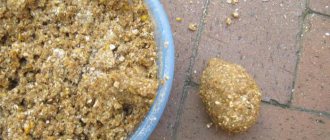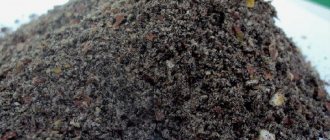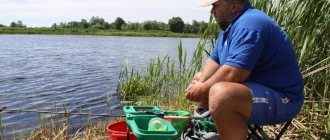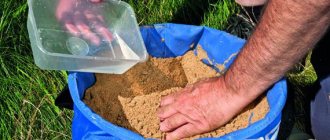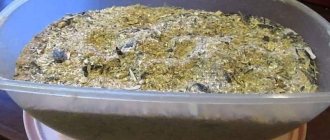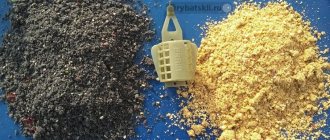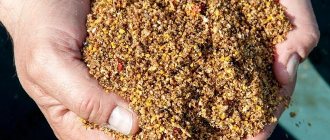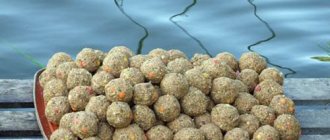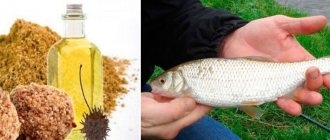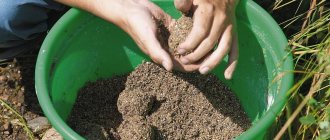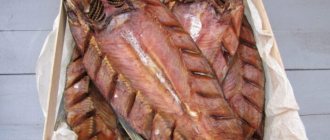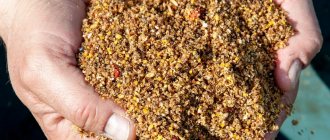Bream is a desirable trophy for feeders. For successful bream fishing, you will need to take care of the correct composition of bait. Bream is a schooling fish that constantly moves around a body of water in search of food. During periods of activity, this fish eats a lot. Another important point is feeding tactics. Therefore, in order to keep the fish on point, it is necessary to use the right feed mixtures and choose the right feeding tactics. Let's look at what should be included in a good bream bait.
Composition of feeder bait for bream
Many fishermen prefer to prepare feeder bait for bream themselves. Mixtures sold in stores are often only a base, to which additional components must be added to obtain good food. In addition to the base, these can be various attractants, molasses, flavorings, large bait fraction and animal components.
Basic complementary feeding
The main role of the base is to serve as an adhesive or filler in the total mass of bait. Adhesive elements are added to the base part so that the final composition is molded and does not fall apart during flight. Small particles are added to the base, as well as dusty elements, which attract fish, but do not saturate them.
The base must have the ability to absorb moisture and flavor from the additional ingredients added. Ground cereals are used as a base, which are additionally fried. This helps reduce stickiness. Bread and other baked goods are also suitable for the base: ground crackers, as well as confectionery products such as cookies, waffles and sponge cakes. When ground into dust, they have reduced nutritional value, but attract fish with the smell of food. Small, attractive particles will make the fish rummage through the food more, keeping it on point.
Read Anton Timoshin's expert article about preparing to catch bream on a feeder and the nuances of fishing.
The color of the base is often selected based on the color of the soil in the pond. The color of the mixture should not contrast strongly against the background of the bottom. If the bottom is dark, then the bait should be dark, and if it is light, then it should be light. To obtain light homemade bait, use bread crumbs from wheat bread, and for dark bait, use crackers from rye bread or sunflower cake. The last ingredient has a good aroma that attracts all the laundry, and also creates a cloud of turbidity and an oily stain. The base portion should be approximately 60% of the total feed volume.
Expert advice
Forester Seva
Expert
Ask a Question
Most often, millet and pearl barley are used as the basic basis for homemade bait. You can add regular sweet corn bought in a store to the food, but only if the bream in the pond is accustomed to such a bait. Ideally, you need to know the preferences of fish in a particular body of water. In any case, only experiments will help you find the right compositions for specific conditions.
The stern and its role
This is the part of the bait that the fish will eat. This is another element that allows you to keep the fish on point. When the bream approaches the point and begins to rummage through the bait mixture, it begins to select the largest and most nutritious particles. The dusty component of the base will attract fish with animation and smell, making them linger and rummage through the food. But if she doesn’t find anything she can profit from, the fish is unlikely to stay for long.
Therefore, add the stern section. These can be the same cereals added to the base: millet, pearl barley and other cereals in the form of whole grains, and not ground into dust. Also, large ingredients such as corn and peas can attract trophies.
The animal component must be added to the bait for bream on the feeder. There is a rule that as bait on the hook, add it to the bait composition.
The optimal bait for different times of the year is a worm. The worm should be added to the bait in a chopped state. They also add food bloodworms, maggots, and caster (pupated maggots).
How to choose in a store
Bags of bait that can be purchased in stores today usually contain all the necessary information, namely:
- what fishing method is the bait intended for?
- at what time of year should bait be used;
- The bait is intended for fishing in currents or in still water;
- composition of the bait.
Additional information can be collected in advance by consulting with colleagues in the hobby and going to fishing forums on the Internet, as well as talking with the seller.
Expert opinion
Knipovich Nikolai Mikhailovich
Zoologist, hydrobiologist. I am interested in fishing at a professional level.
Interesting! There are universal baits and mixtures that are aimed at catching a specific type of fish. If the angler is faced with the task of catching a lot of different fish, then the optimal choice would be a universal bait, and if you want to cut off all the fish that are not interesting, then you should buy bait with the designation “Bream”.
Bait recipes for a bream feeder
It’s easy to make bait for bream with your own hands. Dry ingredients are used to make preparations for bait, which only need to be moistened to the desired state in the pond.
Homemade recipe for summer bait
For this recipe you will need to take the ingredients in the following proportions:
- 1 part peas;
- 1 part millet;
- 1 corn grits and bran;
- 4 parts ground flour.
Salt and sugar are added to add flavor in a ratio of 1:3 and one packet of vanillin.
Millet and peas are cooked until tender. The peas are boiled to a mushy state; the foam does not need to be removed during cooking; it contains nutrients. Peas and millet are salted and sweetened five minutes before readiness. The flour, bran and corn grits are fried and poured into a container. It is better if this container is closed. When fried, these parts release essential oils that have a strong smell. This aroma must be preserved.
Selection of the best store baits
There are many mixtures for bream on store shelves. The price range is wide, from inexpensive to those that are well within your pocket. You can’t make a high-quality composition for little money. The downside of cheap bait is the variability of their composition. The production uses waste from the bakery and confectionery industry. And the proportions in the composition and the quality of the ingredients themselves can vary greatly. In more expensive mixtures, the composition and proportions are monitored. Here are the best commercial feeder baits for bream:
- Sensas (baits from this famous company are divided according to the specifics of the reservoir and color);
- Flagman PRO Next;
- Fish Dream (bream bait options);
- Traper Bream Belge;
- G-Stream.
Choice for different fishing conditions
The choice of ingredients for bait is influenced by the type of fishing. The consistency of the bait mixture for flat bait should be denser and stickier than for a regular feeder feeder. Fishing conditions also influence whether there is a current or not, what time of year it is.
Features of food for cold water
While the water is still cold, in early spring or late autumn, bream are attracted by adding an animal component to the food. For cold water this is a mandatory component. This is mainly maggots, chopped worms or food bloodworms.
These components give the composition a specific aroma, which serves as an attractive feature. In addition, the bait can be additionally flavored with the smell of spices such as coriander, garlic, cinnamon.
While the fish is inactive in cold water, it needs to be fed little by little, so a small amount of food is used. You also need to be careful with fragrances. A strong smell can scare away fish.
Top dressing in summer and spring
Bream eats much more in summer than in cold weather. Therefore, take care of the nutritional value of the composition. It is difficult to overfeed him at this time of year. Therefore, it is better to use a large nutrient fraction. It could be corn, peas, pearl barley. Molasses is added to the composition to increase nutritional value.
In summer, bream switches to feeding on plant baits, although it does not abandon animals. Sweet and fruity aromas work well, such as vanilla, strawberry, chocolate, plum. Unlike cold water, in warm weather the bait can be safely flavored.
On current and in still water
The bait mixture for fishing in the current must contain heavy elements. The bait should lie on the bottom, where the bream feeds. The current creates another condition; it can carry food away from the point. If the bait mixture is light and dusty, it will quickly be carried downstream. To catch bream, the food should form a kind of table from which the fish can feed. To do this, the bait needs to be sufficiently moistened, making it heavy.
Clay or soil from a pond is also added to the finished mixture as a filler. This will darken the bait, make the fish work harder to find food and make it heavier and stickier.
When fishing in stagnant bodies of water, bait does not have the same viscosity requirements. You can use the river version of bait, it will work. You can even make it dusty. Dusty bait will quickly collect roaches and rudd. But where some fish begins to become active and a large school gathers to feast on delicious food, this does not go unnoticed by representatives of other species of fish. And if the roach approaches first, then the bream may follow.
Rules for feeding
When fishing on a feeder
When fishing on a feeder, several casts of a feeder from which the bait is shaken out form a feeding spot. During the fishing process, sometimes additional feeding is carried out, and sometimes this is not done.
When fishing with a float rod
When fishing with a float, at the beginning, a starting feeding with several large balls of bait, which is done manually or using a special slingshot. During the fishing process, additional feeding is carried out with smaller balls.
How to rationally prepare bait
Homemade bait for bream also has some disadvantages. The main one is a ready-made bait containing boiled ingredients, it sours quickly. Therefore, it is better to prepare it right before fishing and in the quantity that will be used during fishing.
Store the mixed bait in the refrigerator, but also for no more than 3 days. Since many baits for bream include peas, it can be prepared in the form of mastyrka and then frozen. And if necessary, take the right amount.
All dry ingredients, such as ground biscuits, crackers, bran, dry grains, feed and cake can be mixed in the required proportion and stored in a tightly closed container.
Differences in the composition of bait at different times of the year
Since the feeding habits of bream vary significantly in different seasons, the bait also has differences in composition.
Spring
In the spring, the bait should include a large number of animal components and a minimum of flavorings. As the water warms up, the proportion of plant ingredients increases, and flavorings can be used more boldly.
Summer
In summer, animal supplements are used only if necessary, but the proportion of nutritional ingredients increases, i.e. various porridges, in which you must include large particles and add those components that are bait, for example, corn, uncooked peas or worms. Flavorings can be used in significant quantities, although you should not overdo it. The amount of bait used in summer is maximum.
Autumn
As water temperatures drop, you should gradually increase the amount of animal supplements, reduce the amount of high-calorie ingredients, and use flavorings carefully.
Winter
In winter, the required calorie content of bait is achieved not through the use of nutritious plant components, but by including animal additives in its composition. Flavorings are used to a minimum.
Feeder feeding technique for bream
Feeding tactics depend on the type of reservoir, fish bite and time of year. In winter you need less feed, in summer you need more. If the bite is good, you need to increase the fishing pace by adding new portions of food.
Another aspect of bream fishing is creating a feeding table. For bream, it is important that the food parts lie on the bottom and there are enough of them to make a profit. Therefore, starting feeding is necessary. With its help, a fed area is created at the bottom.
Tactics for feeding bream. Finding and catching bream.
This article is dedicated to all lovers of bream fishing. The tactics of feeding bream involves a set of measures for successful bream fishing.
Determining where bream is located in a reservoir is not easy even for experienced fishermen. Adults are suspicious of everything. Even the rustle of packages on the shore terrifies them, and the fish take flight. Therefore, you should not create noise.
If you don’t feed the fish, then fishing can be chaotic and boring, and will not give results in the future. So it’s worth studying in more detail about the tactics of feeding bream.
Branded baits.
Currently, there are many branded baits for catching bream. But preparing and serving them is no less important than choosing them. It is necessary to awaken the appetite of this fish in any way.
Choosing bait for bream.
How to choose bait to attract large fish to the fishing spot? For this, appetite stimulants and attractants . This is an important factor and must be taken into account, since the tactics of feeding bream consists largely of bait.
Keeping the bream at the fishing point.
To keep a school of hungry fish at the desired point, they combine baits such as bloodworms, maggots, worms and special clay. Appetite stimulants should not have a strong aroma so as not to scare away bream. That's why they put in a little.
Flavorings are sold in the store. They are used according to the instructions, then they attract a lot of fish, and the bite will be frequent. In addition to signature aromas, bream also bite well on natural attractants such as cinnamon, anise, garlic, and strawberries.
We make up complementary foods.
With the right bait composition, it will quickly gather a school near the fisherman. But if there is an “overdose”, then the fish, having had its fill, will soon leave. The choice of aromatic additives depends on the season. In spring, after wintering, the fish will feed intensively. Bream become greedy and cannot be scared off by an abundance of any food. But in summer the situation changes. Due to increased fishing using feeds of different colors and compositions, bream begins to be cautious. Apparently, he compares the place of catch with the abundance of unusual smells and colors, and avoids them. In this case, the proportion of flavoring should be reduced by 2 times, and less feed should be taken. And replace the edible part with clay. It will attract fish, but will not satisfy them. In strong currents, some of the bait may be washed away by water. In this case, you need to take more of it.
An important part of complementary feeding.
The color of the clay is important. Most often at fishing points it is sold brown. To give it a different shade and attract bream, add one teaspoon of food coloring per 1 kg of clay. If the bite is bad, it is better to use a bright yellow color, which will stimulate the bream’s appetite. To make it saturated, take 1 tablespoon of dye per 1 kg of clay. In addition, there should not be an excess of moisture in the clay, otherwise you can get a viscous, non-rolling mixture. It is advised not to wet it at all, but only to cover it with a damp cloth, which is replaced for several days. The clay is checked when it can be rolled into balls.
The bait is also moistened. The mixture with clay is first sifted, and then maggots, bloodworms or worms are added, and balls of different humidity are rolled. If there are large pieces, the fish will soon be full.
What is it that attracts bream so much?
Products that bream like are widely used. These are corn, barley, seeds, milk powder. In addition, when crushed, they give the bait a misty cloud.
What happens at the bottom of the reservoir.
Some of them should settle to the bottom, and the other part, when dissolved in the water column, should form a light mist, which is very attractive to bream. The balls that fall to the bottom are already used as fish food, since they take a long time to disintegrate. But we must remember that on currents the dry cloud quickly disappears.
There are basic rules for feeding bream tactics.
When preparing the mixture, you need to follow some basic rules. Dry flavors are mixed with dry bait, and only then the mixture is moistened. Liquid ones are first combined with water, to which bait is then added. This increases the efficiency of the mixture. It is also welcome to purchase bait in granules, which are mixed into the composition at the final stage of preparation. This will cause the fish to become active.
Tactics for catching bream.
There are also certain tactics when fishing. Experienced fishermen immediately upon arriving at the fishing site throw about 15 medium-sized balls into the water. They are actively attacked by roach, silver bream, and then bream. If the feeding is correct, then the whole flock can swim. But it often happens that after catching one fish, the bite is complete. Maybe something pushed the fish away, or the school was scattered that day. To find out, experiments are carried out. Mostly they change the bait. For example, maggots, worms, and bloodworms are placed on 1 hook at once. Throwing bombs is effective. These are balls that are rolled in a dry attractant.
Requires testing of bait.
Before throwing the bait far, its effect is tested in shallow water. They lower the ball to the bottom and see how long it takes for it to fall apart. This process should take several minutes.
What else do you need to know about the tactics of feeding bream?
When choosing the color of the bait, you need to remember that bream is shy and will be repulsed by the sharp contrast of the color of the bait with the bottom. In this case, clay from this reservoir is sometimes added to the bait for naturalness.
Interchangeability.
In the summer, when it is hot, the living parts of the bait (bloodworms, maggots, etc.) are replaced with vegetable ones, such as corn.
